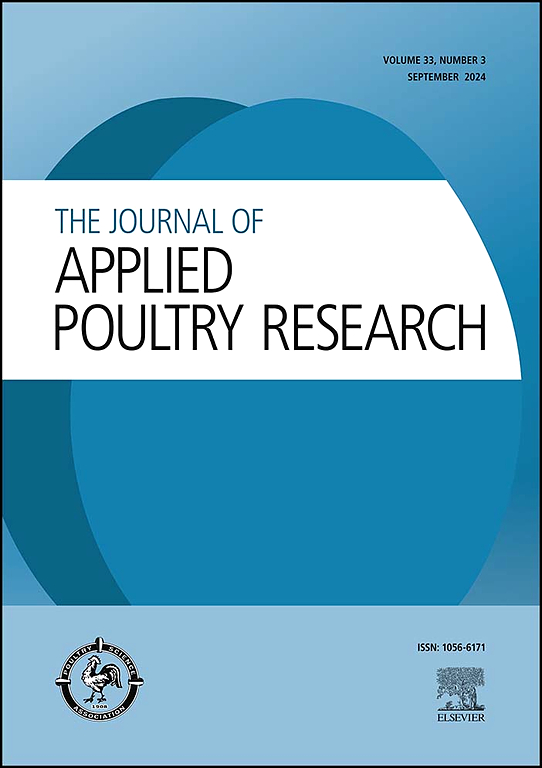鸡源金黄色葡萄球菌分子鉴定及耐药表型分析
IF 2
3区 农林科学
Q2 AGRICULTURE, DAIRY & ANIMAL SCIENCE
引用次数: 0
摘要
对信阳市6个不同规模养鸡场采集的58份病料进行分离培养、PCR和生化试验鉴定,鉴定出36株金黄色葡萄球菌,并进行药敏试验,检测出鸡源金黄色葡萄球菌的16种药物。这些药物的抗菌特性为该地区的临床治疗决策提供了依据。结果表明,在普通营养琼脂上可观察到中等大小、光滑、凸、圆、金黄色的不透明菌落。革兰氏染色和显微镜检查后,发现蓝紫色,球形和不透明的菌落,类似于规则排列的葡萄簇。在营养液中培养后,观察到浊度、沉淀物和细菌环的形成。生化试验符合金黄色葡萄球菌的特点,血浆凝固酶试验呈阳性。对河南省信阳地区4个不同规模养鸡场的58份疑似金黄色葡萄球菌感染样本进行了采集。其中36份经PCR检测为金黄色葡萄球菌。细菌分离率为62%。动物实验证实该分离株为强毒力野生株。鸡源性金黄色葡萄球菌对头孢拉定、头孢氨苄、头孢曲松、红霉素、克林霉素、氧氟沙星、恩诺沙星高敏感,对头孢哌酮、多西环素、阿米卡星、氨苄西林中等敏感,对氨苄西林、恶西林、青霉素、四环素、庆大霉素、复方甲氧苄啶耐药。应优先使用高敏感性抗生素进行治疗,以减少兽药滥用,促进合理用药。本文章由计算机程序翻译,如有差异,请以英文原文为准。
Molecular identification and resistance phenotype analysis of Staphylococcus aureus from chicken sources
The isolation, culture, PCR and biochemical test identification of 58 diseased materials collected from 6 different large-scale chicken farms in Xinyang City, 36 strains of Staphylococcus aureus were identified, and drug susceptibility tests were conducted to detect 16 kinds of drugs against Staphylococcus aureus from chickens. The antibacterial properties of these drugs inform clinical treatment decisions in this region. Test results indicated that on ordinary nutrient agar, medium-sized, smooth, convex, rounded, golden-yellow opaque colonies were observed. After Gram staining and microscopic examination, blue-purple, spherical, and non-transparent colonies were noted, resembling regularly arranged grape clusters. Following culture in nutrient broth, turbidity, sediment, and bacterial ring formation were observed. The biochemical tests aligned with the characteristics of Staphylococcus aureus, and the plasma coagulase test returned positive results. 58 samples of suspected S. aureus infection in four different scale chicken farms in Xinyang area of Henan Province were collected. Among them, 36 samples was confirmed by PCR detection to be Staphylococcus aureus. The bacterial isolation rate is 62%. Animal experiments have confirmed that the isolated strain is a wild strain with strong virulence. Chicken-derived Staphylococcus aureus exhibited high sensitivity to cefradine, cephalexin, ceftriaxone, erythromycin, clindamycin, ofloxacin, and enrofloxacin, moderate sensitivity to cefoperazone, doxycycline, amikacin, and ampicillin, and resistance to ampicillin, oxacillin, penicillin, tetracycline, gentamicin, and compound trimethoprim. The use of high-sensitivity antibiotics should be prioritized for treatment to mitigate the abuse of veterinary drugs and promote rational drug use.
求助全文
通过发布文献求助,成功后即可免费获取论文全文。
去求助
来源期刊

Journal of Applied Poultry Research
农林科学-奶制品与动物科学
CiteScore
4.10
自引率
10.50%
发文量
80
审稿时长
104 days
期刊介绍:
The Journal of Applied Poultry Research (JAPR) publishes original research reports, field reports, and reviews on breeding, hatching, health and disease, layer management, meat bird processing and products, meat bird management, microbiology, food safety, nutrition, environment, sanitation, welfare, and economics. As of January 2020, JAPR will become an Open Access journal with no subscription charges, meaning authors who publish here can make their research immediately, permanently, and freely accessible worldwide while retaining copyright to their work. Papers submitted for publication after October 1, 2019 will be published as Open Access papers.
The readers of JAPR are in education, extension, industry, and government, including research, teaching, administration, veterinary medicine, management, production, quality assurance, product development, and technical services. Nutritionists, breeder flock supervisors, production managers, microbiologists, laboratory personnel, food safety and sanitation managers, poultry processing managers, feed manufacturers, and egg producers use JAPR to keep up with current applied poultry research.
 求助内容:
求助内容: 应助结果提醒方式:
应助结果提醒方式:


